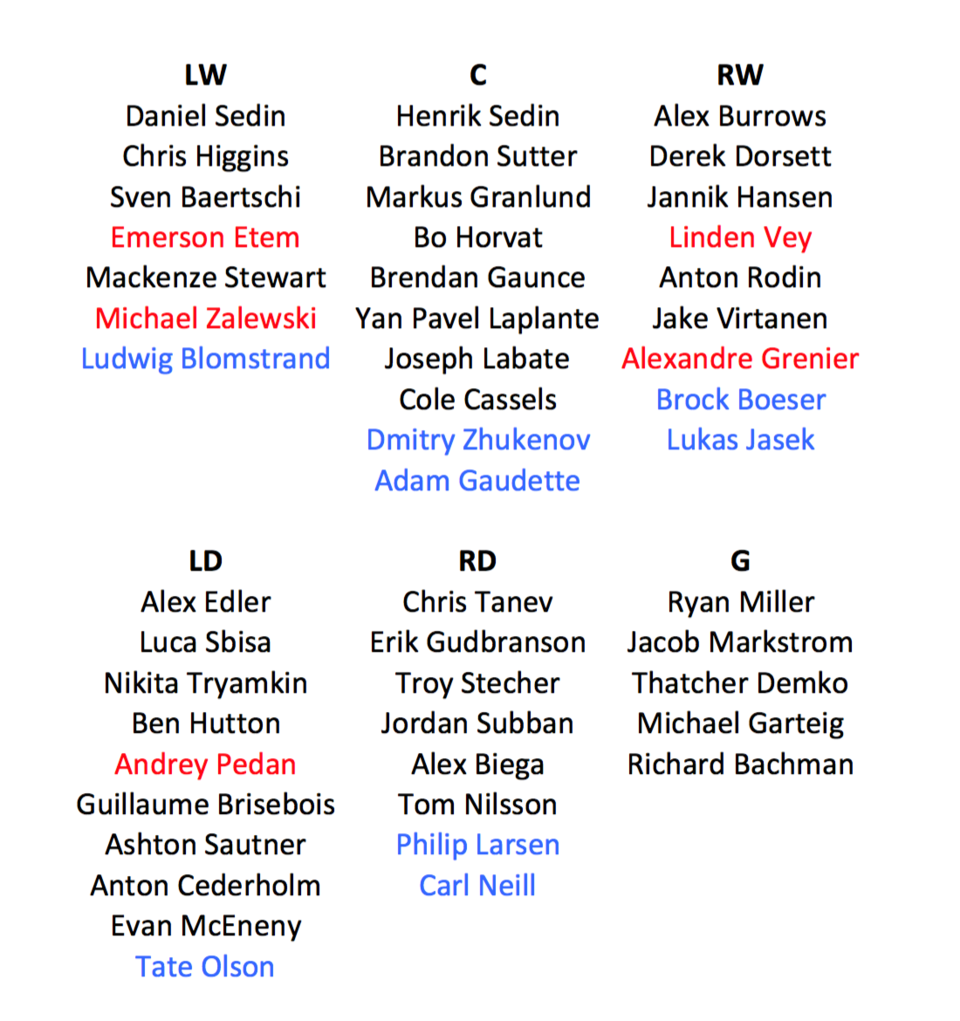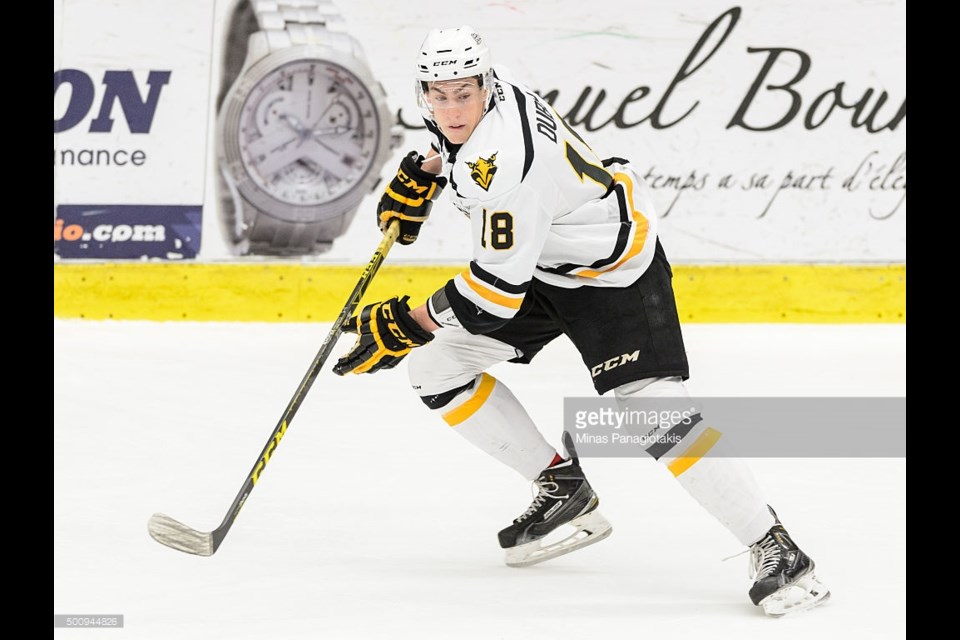I am approaching the upcoming NHL draft this weekend with a mixture of excitement and dread. The Canucks have a chance to shape the future of the franchise thanks to their highest draft pick since they got the Sedins.
Along with the fifth overall pick, the Canucks have a five other picks, with the potential of picking up a few more in trades over the next week. That's assuming they don't trade the fifth overall pick.
It’s easy to talk about who the Canucks should pick in the first round, with the field likely narrowed down to Matthew Tkachuk or Pierre-Luc Dubois, though Jim Benning has said that he “really likes six players” in the range of fifth overall. It’s harder to talk about their later round picks, partly because so much depends on who else gets picked and partly because most of us have limited knowledge about draft-eligible players outside of the first couple rounds.
The number one thing that you’ll hear, though, has to do with a very simplified draft philosophy: pick the best player available.
It’s so simple when you say it that way. Drafting is easy: just pick the best player and you’re set.
Of course, “best player available” is a fiction. Teams at the draft really have no idea who the best player will be when they pick. They’re taking an educated guess based on their scouts, statistics, and overall draft philosophy.
It’s why we constantly see articles redrafting the first round of every draft. When the Canucks picked Cody Hodgson in 2008, he was the “best player available,” but he wasn’t actually the best player available. That turned out to be Erik Karlsson.
As you get further from the first round, the idea of “best player available” becomes an even more relative phrase.
Any team that did figure out how to select the best player available would be a perennial cup contender with a constant flow of fresh, young talent supplementing all the fantastic players they would inevitably lose to the constraints of the salary cap. Just ignore, for the moment, how accurately that describes the Chicago Blackhawks, because they’ve had their fair share of misses at the draft too.
That’s all hindsight, of course. When people say to pick the best player available, they’re not expecting perfection. They just don’t want the Canucks to draft according to need.
The issues with drafting for need are clear: first of all, a team’s needs can change in a hurry. The Canucks drafted Cory Schneider in the first round in 2004 when they had a desperate need for a goaltender. Two years later, the Canucks traded for Roberto Luongo.
Second, drafting for need could lead a team to missing out on a much better player who doesn’t fit the team’s needs. The Florida Panthers needed defence when they picked Erik Gudbranson with the third overall pick, missing out on Ryan Johansen, whose 60 points last season would have been second on the team behind Jaromir Jagr.
But as soon as you get outside the first round—or possibly even the top-three this year—drafting for need isn’t all that outlandish. Heck, even the top three is up in the air as rumours persist that the Columbus Blue Jackets aren’t sold on Puljujarvi at third overall as they might prefer to pick a centre.
Honestly, it makes perfect sense for the Canucks to draft according to need, even as early as the fifth overall pick. Should they pick Matthew Tkachuk, the gritty, playmaking left-winger? Pierre-Luc Dubois, the skilled two-way forward who played his best hockey after shifting to centre? Or should they grab a defenceman, like the smooth-skating and poised Olli Juolevi?
Sure, it’s partly dependent on what the Edmonton Oilers do with the fourth overall pick, but the Canucks have some clear needs: they have limited depth on the left wing, they have no heir-apparent to Henrik Sedin at centre, and have never had a clear number one defenceman in the history of the franchise.
So, technically speaking, the Canucks need Tkachuk, Dubois, and Juolevi. Each of them makes sense. With that in mind, the fifth overall pick could be spent on whichever one of those three (or some other player) that the Canucks deem the “best,” but where the players might be seen as equals, need could have an influence.
But after the first round, the Canucks definitely have to think about need, if not for the current team, then for the system. Let’s take a quick look at the Canucks current system and where they have needs:

Players are listed in order of cap hit, with restricted free agents in red, and unsigned players in blue. It’s unclear if the Canucks retain Ludwig Blomstrand’s rights after he signed in Sweden, not that it matters all that much.
Left wing is an area of strength at the NHL level, with Daniel Sedin, Sven Baertschi, Chris Higgins, Emerson Etem, and (sometimes) Alex Burrows, along with a capable AHL tweener in Michael Zalewski. After that the Canucks have next to nothing in the system after trading Hunter Shinkaruk, with only Mackenze “Next To Nothing” Stewart, the converted defenceman and the Sweden-bound Blomstrand.
Right wing is a strength at both the NHL level and in the system, thanks to Jannik Hansen’s career year with the Sedins, the return of Anton Rodin, and the trajectory of Brock Boeser as the Canucks’ best prospect.
The Canucks have lots of depth at centre, but no real potential first-line centres among their youth. It’s part of the reason I would lean towards Dubois with the fifth overall pick. Not only does he strike me as a better player than Tkachuk, but he might also be the first-line centre the Canucks need. If not, he’ll end up at left wing, also a position of need. Win-win.
On defence, the Canucks have a bevy of left-side defencemen, including five that could potentially play in the NHL in the coming season and a couple with interesting potential in Guillaume Brisebois and Tate Olson.
On the right side, the addition of Erik Gudbranson, Philip Larsen, Troy Stecher, and Tom Nilsson fill out the ranks, while Nikita Tryamkin can also play on the right side. Jordan Subban and Carl Neill wait in the wings, with Alex Biega capable of playing in the NHL in a pinch.
None of the defencemen in the Canucks system look like top-pairing guys, however, let alone a number one. With Alex Edler and Chris Tanev, the Canucks don’t have an immediate need, but one that they need to address in the next few drafts. The Canucks might be better served taking a few swings for the fences outside of the first round in their search for a number one defenceman, however, rather than spending a high pick.
Finally, there’s the goaltending, where the Canucks are set for the season at the NHL level and signed a potential starter and backup combo this year in Thatcher Demko and Michael Garteig. With no other goaltenders in the system, drafting a goaltender or two in the next few years would be advisable.



